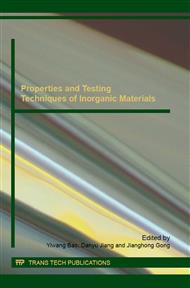p.327
p.331
p.335
p.339
p.343
p.347
p.352
p.361
p.365
Research on High Temperature Creep Properties of Al2O3-SiO2 Ore (Al2O3 ~ 65)
Abstract:
High temperature creep properties of Al2O3-SiO2 ore (65% Al2O3 by mass percentage, abbreviation for Al2O3~65) was studied. The results show that the creep rates at 1300 °C × 50h, 1400 °C × 50h and 1500 °C × 50h were-0.89% ,- 1.75%, - 5.76%,respectively. At 1300 °C, ore has good creep resistance. As the temperature increases, the high temperature creep resistance of Al2O3 ~ 65 bauxite ore is significantly reduced. Creep process can be divided into two stages: when the time t <30h, the sample are in the densification process; after 30 hours, the creep properties show that the relationship between time and the creep rate is linear. At 1300 °C, the absolute value which is the slope of the linear relationship is smaller, exhibited an excellent high-temperature creep resistance. The loading softening-temperature of Al2O3 ~ 65 bauxite ore is 1343 °C. The Sample phase and microstructure are characterized by X-ray diffraction and scanning electron microscopy (SEM). The results show that mullite reticular is formed in sample at 1300 °C; at this point, TiO2 mostly exist as Rutile. At 1400 °C and 1500 °C, TiO2 mostly exist as Aluminum titanate, Corundum phase portion into mullite.
Info:
Periodical:
Pages:
343-346
Citation:
Online since:
February 2016
Authors:
Keywords:
Price:
Сopyright:
© 2016 Trans Tech Publications Ltd. All Rights Reserved
Share:
Citation:


